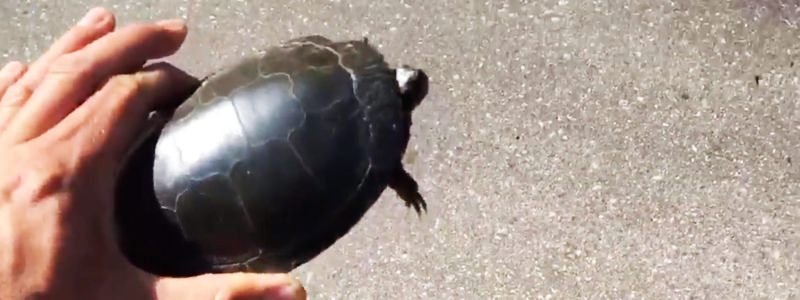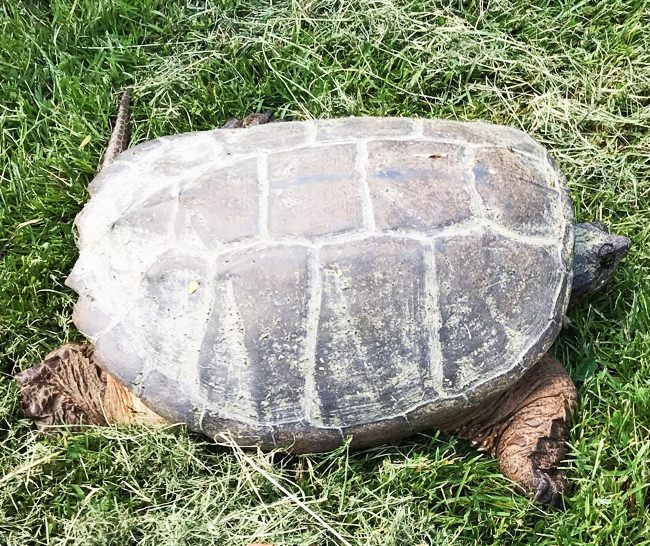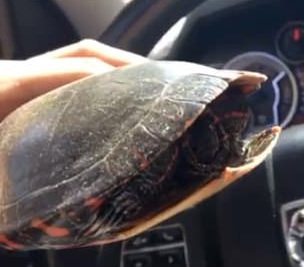
Tips For Encounters With Turtles On Roadways
Posted by Jared Houliston Wednesday, June 26th, 2019 | 5,196 Reads
Summer is here and that means many drivers in Ontario are bound to encounter turtles trying to cross the road. The problem is that a lot of people don’t know that there’s a right way to do it, and that it’s important to help them because in Canada many turtle species are dangerously in decline.
There are different times of the year when turtle encounters on the road are more prevalent. The times of the year when motorists should be on the lookout for crossing turtles is between the months of April to November, but the major traffic crossings start in and around the latter days of June.
 The issue of fatal turtle crossings is becoming a national epidemic. Every year, wildlife conservation and wildlife rehabilitation groups in Canada are reporting hundreds of incidences of injured or killed turtles on the roadways. The problem is only progressively being aggravated by the reduction of their wetlands and their natural habitat through continued industrial expansion projects.
The issue of fatal turtle crossings is becoming a national epidemic. Every year, wildlife conservation and wildlife rehabilitation groups in Canada are reporting hundreds of incidences of injured or killed turtles on the roadways. The problem is only progressively being aggravated by the reduction of their wetlands and their natural habitat through continued industrial expansion projects.
Today, the Midland Painted Turtle is now classified as a species at risk by the Committee on the Status of Endangered Wildlife in Canada (COSEWIC) and the species is in an unfortunate decline.
Do your part and help a turtle out
One easy way we can do our part in preserving this wonderful species and helping other turtles species survive, is by taking an active approach to encounters we have with them on the road.
This is how you safely help turtles cross a roadway
- If it’s night time, keep your car headlights on and pull over
- Determine if you need a tool like a stick to prod the turtle across
- Yield any oncoming traffic so the turtle can cross safely
- Take note of the direction the turtle is going in
- Pick up the turtle by its shell and bring it in the direction it was going
- Place the turtle about 10 feet away from the roadway
- Report the turtle sighting to a wildlife conservation group
All turtle sighting should be reported, and reporting sightings can be done here.
View video of the steps to take to help turtles cross roads safely:
How to safely pick up a turtle
The safest way to pick up a turtle before helping it cross the road is by calmly walking up behind it, and picking it up by the backend of its shell.
 Holding the turtle with two hands is more safer and allows you to get a good grip on it so it doesn’t fall – and it helps reduce the risk of getting bitten by it.
Holding the turtle with two hands is more safer and allows you to get a good grip on it so it doesn’t fall – and it helps reduce the risk of getting bitten by it.
Be very careful because most turtles will bite someone to protect itself or if you come to close to its face. If you encounter a snapping turtle, be especially aware that they have a notorious reputation for severely injuring people’s fingers or biting them right off.
DID YOU KNOW? If you try to pick up a turtle by its tail you can injury it. Picking up a turtle by the tail can dislocate parts of its tail-bones which then becomes very painful, and can potentially paralyze it
What if the turtle is too big to pick up?
If the turtle is too big or heavy, don’t bother trying to pick it up yourself because you both can be severely injured.
Instead, try to yield any traffic so the turtle can continue to cross the road on its own safely, and then make sure to call your local wildlife rehabilitation services to report the sighting.
If it’s just standing in the middle of the road and doesn’t appear to be going anywhere, use a large tree branch to prod it on its way. Eventually it will get tired of you bothering it and be on its way. Note that if it’s injured or sick, it make not continue to cross at all so if it still won’t move, guide traffic around the turtle and call local wildlife rehabilitation and let them know.
They’ll send someone with more experience with wildlife out to the scene to help you.
How does the turtle know where it’s going?
Turtles like many other mammal-like reptiles sense invisible lines in the earth’s magnetic field. Studies have shown that turtles can wander tens of miles away from their original nest and read the magnetic field in order to find their way back to their birthing site if they so wish to do so.
Even if you place the turtle in the wrong direction after helping it cross the road, it will still figure out which direction it was originally going in and start back on it’s route again.
What if you encounter turtle eggs?
Many people find that turtles lays their eggs on the side of the road so if you see a nest, simply lay four sticks around the nest and if you can, place caution-tape on the sticks. You can also stick a sign into the ground or surround the nest with pylons so others can see the nest and avoid hitting or disturbing it.
Safety first
Encounters with any form of wildlife can be dangerous, and the situation becomes especially dangerous when you’re getting out of your car on roadways. Always practice safety first, and try to maintain as little contact with the turtle as possible but do your best to get it across safely. Your kind actions may actually help us take a few turtles of the ‘species at risk’ list.
Feel free to share this article or tell us about your experiences with helping turtles cross the road in the comments below.
Ontario Wildlife Removal Inc. provides wildlife removal and pest control in Southwestern Ontario, including Brantford, Kitchener-Waterloo, Cambridge, Guelph, London, Woodstock, Tillsonburg, Simcoe, Port Dover, Paris, St. George, Six Nations, Caledonia, Burlington, Waterdown, Oakville, Hamilton, Stoney Creek, Grimsby, & Niagara Region. Our methods are safe, humane and environmentally friendly. Call today to book your inspection.
Get a Pest Control Quote
Simply fill in your details below and we'll call you very shortly to discuss your issues.





Leave a Reply